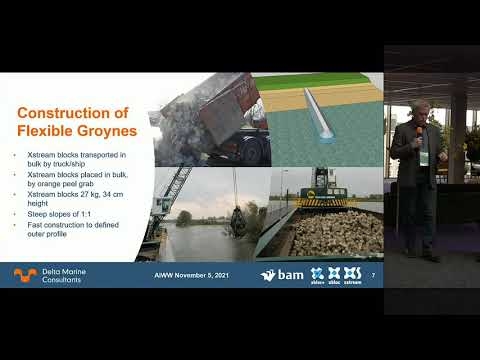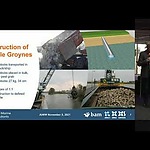The existing groynes are impermeable structures which have a large scour protection around the groyne heads. Near the head of these groynes large scour holes are formed due to flow concentration and turbulence. Sand eroded from these scour holes can form local sand waves in the shipping channel (in Dutch kribvlammen). These local sand waves form an obstruction for the inland shipping
Due to climate change the hydraulic boundary conditions for rivers are changing. There is more extreme rainfall, and extreme river discharges increase. The floods which previously occurred only in winter now also occur in summer. Rivers adapt to climate change and also adapt to manmade changes such as shortening the river length by cutting off river bends. Therefore, in the Netherlands river beds are deepening. Because of increasing river flow and changing bed levels, damage occurs at river groynes such as outflanking at the root of the groyne. As the existing groynes have multiple layers and transitions they cannot be easily adapted to the increasing boundary conditions due to climate change.
As groynes are located at right angles to the river flow, they form an obstruction to the river flow at extreme discharges and lead to increased water levels in the river, which are dangerous for water safety. Therefore, at many locations in the Netherlands groynes are being modified by lowering the crest height to increase the discharge capacity. Due to the many layers and transitions in traditional groynes, this is difficult to do. In addition, inland water transport on Dutch rivers is increasing. Inland ships increase in size and have bigger engines. The waves and currents caused by these ships lead to erosion of the bank and outflanking of the groynes, therefore traditional groynes require continuous maintenance.
A concept has been developed by BAM called “Flexible Groynes”. Flexible Groynes are built from only 1 material, called Xstream blocks. Xstream blocks are concrete X-shaped blocks of 35 cm height and 28 kg weight. As they interlock, they can be placed on steep slopes of up to 1:1. The porosity of a Flexible Groyne with Xstream blocks is 60%. So, only 40% of the structure is concrete. Low strength concrete with low CO2 footprint binders can be used. Flexible Groynes are only made of Xstream blocks. So there are no transitions, no geotextiles no rock or wood. The CO2 footprint of a Flexible Groyne is less than half that of a traditional groyne because of the large reduction in material quantities.
The Flexible Groyne adapts to changing river bed levels. If required because of climate change or other reasons, it is very easy to shorten, lengthen or change the height of the groyne. Xstream blocks can be placed in bulk, by dumping or using a crane with a big grab which places 20 blocks at a time.
Because of the porosity of the Flexible Groyne, wave energy of ship waves is absorbed. Since no scour protection with fascine mattresses is required, sand can move more easily around the groyne head and unwanted local deep scour is reduced. Flexible groynes have a high porosity and can therefore form a habitat for river life. During a pilot in the IJssel river in the Netherlands, 3 pilot groynes have been built and monitored in cooperation with the partners (Rijkswaterstaat, Van den Herik, Deltares, BTE, Meteoor and Aquatic Drones) and provided by the leerruimte Self Supporting River Systems. More projects with Xstream blocks are being planned.
In-person Conference

